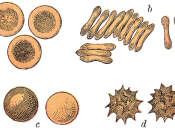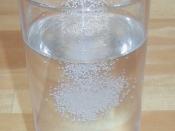Aim
The aim is to find the concentration (mole/dm3 (M)) of solute in a potato cell by using the process of osmosis and different concentrations of sucrose solution.
Background information
Osmosis is diffusion of water across a partially permeable membrane. It moves from a solution with less solute concentration (high water potential) to a solution with more solute concentration (low water potential). The one with a high water concentration is called a hypotonic solution and the low water concentration is called hypertonic solution, but these only depend on what type of concentration is on the other side of the partially permeable membrane. When more water passes through to one side of the membrane it is called net movement.
(Toole + Toole "Essential AS level Biology")
This is an example of the net movement through a partially permeable membrane. The right side is the more dilute solution, which makes it the hypotonic solution.
The left side is the less dilute solution, which makes it the hypertonic solution. Net movement occurs through the more dilute to the less dilute so it goes from left to right though the partially permeable membrane. As you can see, the dotted line going horizontally through the middle of the two levels of solution shows the level of the solutions at the beginning when the two sides where given equal amounts of its solution. The horizontal solid lines show the level of the two sides after it was left for 2 hours. The right side has more solution in it because of the greater net movement of water going to the right from the left side by the process of osmosis.
(Marveen "GCSE Biology")
This diagram is of two liquids separated by a partially permeable membrane. The left side has large molecules of solute that has dissolved...


